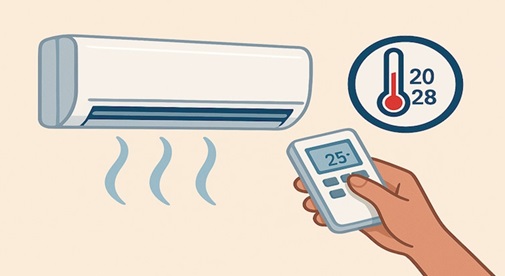|
(Prelims: Current Affairs)
(Mains, General Studies Paper-2: Issues arising out of government policies and interventions for development in various sectors and their design and implementation)
|
Context
Union Power Minister Manohar Lal Khattar has proposed guidelines to standardize the operating temperature limits of air conditioners across the country.

About the proposed guidelines
- As per the proposal, no AC will now operate at a temperature below 20 °C or above 28 °C, i.e. users will not be able to set the temperature below 20 °C or above 28 °C.
- The proposed guidelines are based on the 2018 plan presented by the Bureau of Energy Efficiency (BEE). The detailed guidelines have not been revealed yet.
- This will mainly apply to new air conditioners, while large commercial establishments (such as malls or offices) using centralised AC systems may be out of the purview.
Reason for the proposed guidelines
- Energy savings: Running ACs at very low temperatures increases power consumption drastically. Maintaining temperatures between 24°C-28°C can significantly reduce energy consumption.
- Misconceptions busted: Many people believe that setting the temperature too low cools the room quickly, while the truth is that the efficiency of an AC depends on its tonnage and not the temperature setting.
- Public interest: This move can be seen as an initiative towards collective responsibility and public interest, just like the helmet law.
Possible impact
- Limited personal inconvenience: This rule will mainly affect people who like to keep their rooms below 20°C.
- Promotes energy conservation: This initiative will motivate people to use ACs more responsibly.
- Environmental benefits: Reduction in demand for electricity will reduce the need for coal-based power generation, which will also reduce carbon emissions.
- Reduction in pressure on the grid: During extreme heat, excessive use of AC increases pressure on the grid, leading to blackouts. This rule can reduce this pressure.
AC Load and Demand in India
- BEE estimates that at current market trends, the total connected load in India due to air conditioning will be around 200 gigawatts (GW) by 2030 and may increase further as currently only 6% of households use one or more air conditioners.
- India's cooling demand is around 50GW or about one-fifth of India's peak electricity demand.
|
Also read:
- Japan encourages a default setting of 28 °C for air conditioners in offices and public buildings.
- Italy has set a minimum temperature of 25 °C for cooling in public buildings such as schools and post offices.
- In the US, it is recommended to keep ACs at 25.5 °C when people are at home.
- Spain passed a law in 2022 that requires cooling in public places, offices and commercial buildings to be no lower than 27 °C.
- Australia does not impose any limits on thermostat settings but state guidelines suggest keeping the temperature between 22 °C and 24 °C.
|
Other aspects
- Need for public awareness: There is a lack of scientific information related to AC usage among the general public. This rule can become an opportunity to spread awareness.
- Preparedness of manufacturers: Companies have indicated that they are capable of implementing these changes in two to three months.
- Energy efficiency codes and building design: Energy efficient building codes already exist in the country but their scope of compliance is limited. If these are implemented properly, the need for AC can be reduced to a great extent.
Way Forward
- Provide subsidy or tax exemption on purchase of 5-star rated ACs.
- Run exchange programs for old low-efficiency ACs.
- Allow only high-efficiency models in government procurement.
- Bureau of Energy Efficiency’s (BEE) star rating system should be made more stringent and updated so that only truly efficient products get high ratings.
- Encourage schemes to run ACs from renewable sources like solar energy.
- Revive traditional Indian techniques of green building design and ventilation in urban schemes.
Conclusion
The standardization of temperature limits of air conditioners proposed by the government is a subtle but far-sighted move. It can simultaneously serve multiple purposes like energy conservation, environmental balance and public awareness.